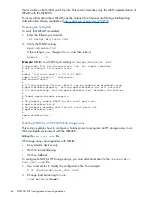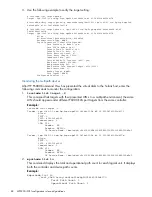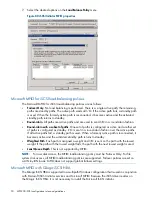
The bindings file ensures that the SCSI number in the
symlinks
device (described in
“Assigning
device names” (page 78)
) always maps to the same iSCSI target.
NOTE:
Linux dynamically allocates SCSI device nodes as SCSI devices are found; therefore, the
driver cannot ensure that a SCSI device node (for example,
/dev/sda
) always maps to the same
iSCSI target name. The
symlinks
described in
“Assigning device names” (page 78)
provide
application and
fstab
file persistent device mapping; use these
symlinks
instead of direct
references to SCSI device nodes.
If the bindings file grows too large, you can edit the file and remove the lines for targets that no
longer exist. This should not be necessary because the driver can maintain up to 65,535 bindings.
Mounting file systems
The Linux boot process typically mounts the file systems listed in
/etc/fstab
before the network
is configured; therefore, adding mount entries in iSCSI devices to
/etc/fstab
does not work.
The
iscsi-mountall
script manages the checking and mounting of devices listed in
/etc/fstab.iscsi,
which has the same format as
/etc/fstab
. This script is invoked
automatically by the iSCSI startup script.
NOTE:
If iSCSI sessions are unable to log in immediately due to network or authentication
problems, the
iscsi-mountall
script may time out and fail to mount the file systems.
Mapping inconsistencies can occur between SCSI device nodes and iSCSI targets (for example,
the wrong device is mounted because of device name changes resulting from iSCSI target
configuration changes or network delays). Instead of directly mounting SCSI devices, HP recommends
that you do one of the following:
•
Mount the
/dev/iscsi symlink tree
.
•
Mount the file system UUIDs or labels (see the man pages for
mke2fs
,
mount
, and
fstab
).
•
Use the Linux Logical Volume Manager.
Unmounting file systems
You must unmount all file systems on iSCSI devices before the iSCSI driver stops. If the iSCSI driver
stops while iSCSI devices are mounted, buffered writes may not be committed to disk, and file
system corruption may occur.
Linux does not unmount file systems that are being used by a process; therefore, any process using
those devices must be stopped (see the man page for
fuser(1)
) before iSCSI devices can be
unmounted.
To prevent file system corruption, the iSCSI shutdown script automatically stops all processes using
devices in
/etc/fstab.iscsi
. The script sends a SIGTERM signal to stop the processes, followed
by a SIGKILL signal to stop any remaining processes. It then unmounts all iSCSI file systems and
stops the iSCSI daemon, terminating all connections to iSCSI devices.
CAUTION:
File systems not listed in
/etc/fstab.iscsi
cannot be unmounted automatically.
Presenting P6000 EVA storage for Linux
To present P6000 EVA storage for Linux:
1.
Set up the LUNs by using HP P6000 Command View, as described in
Step 4
.
Setting up the iSCSI initiator
79
















































